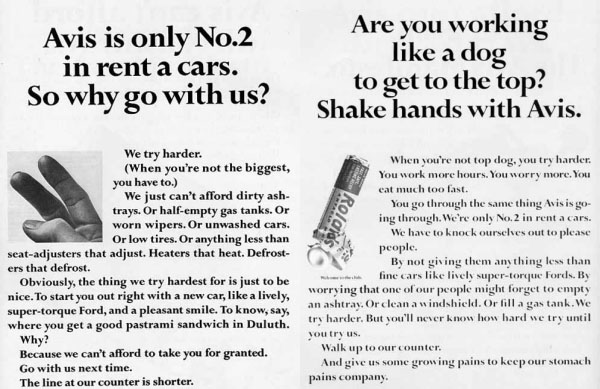Today I received an interesting question. In the midst of mounting competition a friend was discouraged with his new business. He was convinced that his business was at a severe disadvantage, how could he compete against larger companies with deeper pockets? Here’s his message:
“My issue is that there are a ton of companies already providing the same services we offer. I believe business owners are very likely to ignore my message and just paint me with the same brush as everyone else making it too hard for me to actually get through and make sales. If you put yourself in the decision makers shoes would you choose someone who is brand new or a competitor who may have 4+ years experience?”
This thought process is not uncommon, even established companies struggle with their perception of the competition. It’s easy to find thousands of measures where your company is dis-advantaged. It’s frustrating to see competitors with large-scale advertising campaigns, new facilities, countless employees, low-ball offers and seemingly unlimited bank accounts. How can you compete against the big boys?
If you’re like me, you like being #1. Being second, third or even last place is difficult to swallow. If you ever hope to get to #1 there is a seemingly impassable mountain to climb, it’s probably impossible. You must realize and accept that your unlikely to beat ALL your competitors, the great thing about business is that you don’t need to be #1 to succeed.
Whenever you begin questioning your ability to compete against an established company, take a look at the famous 1963 Avis advertising campaign. At the time Avis was number 2 in car rentals by a significant margin. (Hertz was #1) Avis turned their market position into a positive. Their message was simple: “Avis is only No. 2 in car rentals. Why choose us? We try harder.” This method of repositioning gave customers a reason to choose Avis, everybody loves an underdog!

This preface leads to the all-important question, how can you compete against the big guys? How can you get visitors and sales with limited resources? How can you stand out among all of the competitor noise?
The answer is positioning.
It is imperative that you position yourself clearly and in a manner that customers can understand. You must give customers a reason to choose your business and you must emphasize that reason every chance you get. Forget stock answers like “We are the best…”, “We offer the lowest prices…”, “We do a better job”, etc. Even if true, they mean absolutely nothing to customers. They are just more noise.
One position I like is from a local flooring company. Their message is:
“We aren’t perfect, we make mistakes. The key is how we handle those mistakes. We make things right every time. We stand behind what you stand on.”
Anyone that has ever done any home improvement knows things go wrong — it would be naive to believe ANY flooring company gets it right every time. It’s a brilliant position to acknowledge an industry short-coming and focus on the end result, how they handle problems.
How to establish a powerful position?
1. Know Thy Customer
The first step in determining your positioning strategy is by looking through the eyes of your customer. Customers don’t care about what you sell, they want to solve a problem. They want to take away a problem, remove pain, solve inconvenience and make their life better. Your products and services are simply a way for them to achieve those goals. For instance, nobody really needs a drill. People need to make holes. People need to fasten screws to complete repairs or build products that improve their life. The key is what your product or service does. The drill itself is not important, it’s about what the drill can do.
2. Focus on Un-changing Desires
The second step is making sure you focus on the unchanging desires of your customer. You must focus on factors that will always be important to the customer. A local manufacturer used to position themselves as “The quality truck accessories people.” While this position expressed what they sold, it did not express customer desires. As the company begins to grow into other segments they must battle this entrenched position, customers only associate them with truck accessories. A product-based positioning strategy puts your company in a box and that’s never a good thing. Compare this to a position of something like “We improve the usefulness and extend the life of the products you depend on. We put more life into your world.” If you were to choose between the two, which would you pick? I’m guessing the latter.
3. Do it Yourself
Finding a powerful position for your company is not easy. It’s not like picking a baby name where there is a book of options. Positioning your company requires knowing the details of your company, common objections and customer traits. It’s not something you should put in the hands of an outsider, even an expert or marketing agency. Your position should come from within. The owner and top salespersons are the leading candidates, it must come from people that understand the company’s pulse. An outsider can help with formatting or verbiage, but the core message must start from within. Giving outsiders free reign in positioning your company is a recipe for disaster.
4. Keep it Brief
You should be able to state your position fully in no more than 5 sentences. Restrict your stated position to words which give meaning and focus, avoid generic terms. Please keep in mind that your position is not to be confused with a “tag-line.” One sentence is generally not enough to define your position. A tag-line could be part of your position, but be sure to provide context when developing your positioning statement. For example, the flooring company mentioned uses “We stand behind what you stand on.” as their tag-line, but provides additional context in their positioning strategy.
5. Get Customer Feedback
If you already have a group of loyal customers see what they think. If you’re struggling to create a positioning statement, ask your customers why they chose you. Continue to get feedback during the process, try constructing 3-4 potential positioning statements and ask customers which best represents your company. Instead of getting feedback from family and friends (who will always say nice things), ask the critics that matter — the customers that pay your bills. Many people believe that asking customers for feedback makes you look inept or weak, this is false. Customers like your business and want it to succeed, knowing that you value their opinion only strengthens that relationship. This process isn’t grueling, it’s as simple as making a call or sending an email. Here’s an email you could send:
Thanks for being a loyal customer, we appreciate your business. In order to improve our marketing I’d like to ask you for some quick feedback. Would you mind telling me 3 strengths and 3 weaknesses of XYZ Corporation? What is the #1 reason you choose XYZ Corporation? Any input you provide would be helpful in gaining insights about how we can improve our operations.
Use Your Position
Once you’ve established a powerful position, use it! Make sure that employees know your position and believe in it. Your operations should reflect the position in all aspects — not just your marketing. Your website should introduce visitors to your company’s position prominently, everyone should have a reason why they should choose you.
Your competitors may have you beat in other aspects, but you can win business with words.
In most cases bigger companies have more generic positions or they may not publicly position themselves at all. And arrogant positions, such as “Choose us because we are #1” don’t resonate with consumers — smile when you see competitors using those statements.
With proper positioning your company can quickly grab market share from ANY competitor. Once you find a positioning message that resonates with customers all your efforts will feel like clockwork. Customer retention and advertising conversion rates will reach new heights as your organization operates with a customer-centered attitude.
Collect your stones and don’t fear Goliath!


